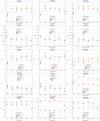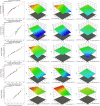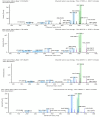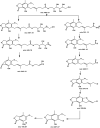AQbD based green UPLC method to determine mycophenolate mofetil impurities and Identification of degradation products by QToF LCMS
- PMID: 36352016
- PMCID: PMC9646803
- DOI: 10.1038/s41598-022-22998-0
AQbD based green UPLC method to determine mycophenolate mofetil impurities and Identification of degradation products by QToF LCMS
Abstract
We report an ideal method for quantifying impurities in mycophenolate mofetil drug substances and their oral suspension preparations. We developed a systematic and eco-friendly analytical approach utilizing quality by design (QbD) and green chemistry principles. Initially, the critical method parameters (CMPs) were screened using a D-optimal design. The robust final method conditions were optimized using a systematic central composite design (CCD). Through graphical and numerical optimization, the protocol conditions were augmented. The pH of mobile phase buffer (25 mM KH2PO4) (MP-A), initial gradient composition (% MP-A), flow rate (mL min-1), and column oven temperatures (°C) are 4.05, 87, 0.4, and 30, respectively. The best possible separation between the critical pairs was achieved while using the Waters Acquity UPLC BEH C18 (100 × 2.1) mm, 1.7 µm analytical column. A mixture of water and acetonitrile in the ratio of 30:70 (v/v) was used as mobile phase-B for the gradient elution. The analytical method was validated in agreement with ICH and USP guidelines. The specificity results revealed that no peaks interfered with the impurities and MPM. The mean recovery of the impurities ranged between 96.2 and 102.7%, and the linearity results r > 0.999 across the range of LOQ - 150%. The precision results (%RSD) ranged between 0.8 and 4.5%. The degradation products formed during the base-induced degradation were identified as isomers of mycophenolic acid and sorbitol esters using Q-ToF LC-MS and their molecular and fragment ion peaks. The developed method eco-friendliness and greenness were assessed using analytical greenness (AGREE), green analytical procedure index (GAPI), and analytical eco score, and found it is green.
© 2022. The Author(s).
Conflict of interest statement
The authors declare no competing interests.
Figures








References
-
- United States Pharmacopeial Convention, Rockville, Maryland, USA, USP43-NF38, 3043–3052. 10.31003/USPNF_M55070_04_01
-
- Satishchandra MH, Singhvi I, Raj H. Forced degradation studies and development and validation of stability-indicating RP-HPLC chromatographic method for mycophenolate mofetil assay and related substances. Int. J. Pharm. Pharm. Sci. 2018;11:14–24.
-
- Protic A, et al. Structural elucidation of unknown oxidative degradation products of mycophenolate mofetil using LC-MSn. Chromatographia. 2016;79:919–926. doi: 10.1007/s10337-016-3092-2. - DOI
-
- Protic A, Zivanovic L, Radii M, Luevi M. Impurity profiling of Mycophenolate Mofetil with the assisstance of desirability function in method development. J. Liq. Chromatogr. Relat. Technol. 2011;34:1014–1035. doi: 10.1080/10826076.2011.569809. - DOI
-
- Choudhari VP, Nikalje APG. Development and validation of stability indicating LC-PDA method for mycophenolate mofetil in presence of mycophenolic acid and its application for degradation kinetics and pH profile study. Adv. Chem. 2014 doi: 10.1155/2014/719385. - DOI
Publication types
MeSH terms
Substances
LinkOut - more resources
Full Text Sources
Miscellaneous

